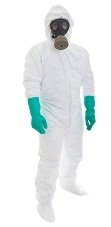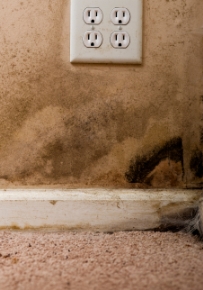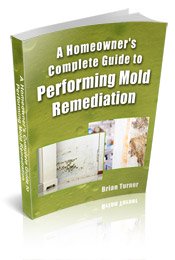Find a Mold Specialist Now
Click or Call, Toll-Free 24/7
How to Clean Black Mold
Many people want to know how to clean black mold themselves because they don’t want to spend a lot of money hiring a professional for black mold clean up jobs. That’s understandable, and if you have only small amounts of mold, you may be able to tackle the job yourself. We’d like to talk to you about safely though, because removing black mold can be a dangerous job. When you are cleaning up mold, the mold spores often drift into the air. Inhaling them can cause all sorts of health problems, some of them quite serious, like asthma attacks, other respiratory disorders and autoimmune conditions.
How to Clean Black Mold Safely

If you’re going to clean up black mold, you need to obtain the proper safety gear. You should have:
- N-95 respirator facial mask (other types of facial masks may not filter out all mold spores).
- Latex or vinyl gloves (disposable).
- Disposable shoe covers.
- Disposable hair covers.
- Pants and a long-sleeved shirt that you can launder in hot water immediately after completing the job, or even better would be a disposable tyvek suit.
- Large sheets of plastic and duct tape (hang the plastic over the doorway to the room in which you’ll be doing black mold clean up and over any HVAC ducts to prevent mold spores from drifting into other areas).
- A negative air machine for larger jobs.
Getting Started with Your Black Mold Clean Up
If the mold you will be cleaning up appears to be dry, use a spray bottle of water to moisten the mold before you start cleaning it up. This will help to prevent mold spores from drifting to other areas.
Scrub the moldy area with soap and water. Then clean it again with a product designed to kill black mold, such as Foster 40-80. You can find suitable products at most hardware stores and home improvement stores.
Of course, this technique only works if you are dealing with mold on a hard surface, like a non-porous wall or floor. Mold can grow in other areas that are much more difficult to clean, such as inside walls, inside heating ducts and underneath carpet.
How to Clean Black Mold inside Walls, Under Carpet and in Other Hidden Places

Before you can begin black mold clean up in these “hiding places,” you have to find it. That can be quite a challenge. If you’re not sure if you have hidden mold or aren’t sure how to find it all, you can call a mold removal specialist to help you. Most will come to your home and inspect for mold with no cost to you. They’ll let you know what work you need done.
You will need to remove any insulation, drywall or sheetrock, carpet, padding under carpet and other porous materials that have been contaminated with black mold because they cannot be adequately cleaned or disinfected. Seal any materials in heavy plastic bags before disposing of them so that you do not inadvertently spread mold spores.
Sometimes mold cannot be removed from studs in the wall or from floorboards. Professionals may recommend encapsulation, a technique in which a sealant is applied over the mold to prevent it from spreading further. You can purchase such sealants at most home improvement stores but encapsulation is only considered an appropriate way to deal with mold under very specific circumstances and we recommend consulting with a professional before you try it.
For More Information
For more information about how to clean black mold, we recommend “The Homeowners Complete Guide to Performing Mold Remediation” by Brian Turner. To learn more about this book, follow the link. You can also schedule a free consultation with a mold removal specialist for some professional advice.
When You Need to Contact a Professional
There are some circumstances in which it is advised to contact a professional mold removal specialist.
- If you have mold that covers an area greater than ten square feet, the Environmental Protection Agency recommends calling a professional.
- If you have mold in your heating and air conditioning ducts, special equipment is needed and the job is fairly difficult.
- If you have moldy wood, such as studs in your walls or floorboards, it’s wise to consult a professional about whether or not encapsulation is the best technique to use.
- If you have health problems like respiratory disorders, disorders of the immune system, or allergies, or if you’re pregnant, you should not attempt to remove mold yourself for health and safety reasons.
Follow this link to find a Mold Removal Specialist offering free consultations in your town.
Return From How To Clean Black Mold To Getting Rid Of Black Mold
Black Mold Health Symptoms Home Page





